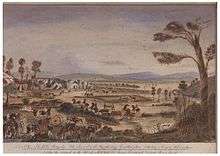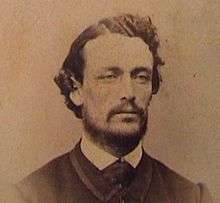Cullin-la-ringo massacre
The Cullin-la-ringo massacre, known historically as the Wills tragedy, occurred north of modern-day Springsure in Central Queensland on 17 October 1861. It remains the largest massacre of white settlers by Aboriginals in Australian history,[1] and a pivotal moment in the frontier wars in Queensland.[2]



Massacre
In mid October 1861, a squatter party from the colony of Victoria under Horatio Wills began a temporary tent camp to start the process of setting up the grazing property of Cullin-la-ringo. Wills's party, an enormous settlement train including bullock wagons and more than 10,000 sheep, had set out from Brisbane eight months earlier to set up a farm at Cullin-la-ringo, a property formed by amalgamating four blocks of land with a total area of 260 square kilometres (64,000 acres). The size of the group had attracted much attention from other settlers, as well as the Indigenous people.
According to the account of one of the survivors, John Moore, Aboriginals had been passing through the camp all day on 17 October 1861, building up numbers until there were at least 50. Then, without warning, they attacked the men, women and children with nulla nullas. The settlers defended themselves with pistols and tent poles, but nineteen of the twenty-five defenders were killed.
Those killed were Horatio Wills; David Baker, the overseer; his wife, Mrs Catherine Baker; their son, David Baker, Jr.; the overseer's daughter, Elizabeth Baker (aged 19); Iden Baker (a young boy); an infant Baker (8 months old); George Elliott; Patrick Mannion; his wife, Mrs Mannion; their three children (Mary Ann Mannion, 8 years old; Maggie Mannion, 4 years old; and baby Mannion, an infant); Edward McCormac; Charles Weeden; James Scott; Henry Pickering; George Ling; and a bullock driver known as Tom O'Brien (who had been engaged at Rockhampton).
The six surviving members were Tom Wills (Horatio's son, noted as an outstanding cricketer and co-founder of Australian rules football); James Baker (David Baker's son); John Moore; William Albrey; Edward Kenny; and Patrick Mahony. These men either were absent from the camp or, in Moore's case, managed to avoid being seen. It was Edward Kenny who subsequently rode on to report the massacre, arriving at the neighbouring Rainworth Station the following day. Moore was the only white eyewitness to the event.
Response
— P. F. MacDonald, squatter who sold Cullin-la-Ringo to Horatio Wills[3]
The first to go out in pursuit were a vigilante party of eleven heavily armed white settlers assisted by two trackers. Judging by the more than fifty camp fires, they pursued what was estimated to be "probably not under 300, and of these 100 may be assumed as the number of fighting men."[4]
The Aborigines continually used ground that prevented the whites from using their horses to full advantage: "they chose stony and difficult ground wherever they had it in their power".[4] Yet the whites eventually managed to catch up with them on 27 November 1861 and at "half-past two a.m. on Wednesday morning their camp was stormed on foot with success."[4] From this account, the number of Aboriginal casualties was very high, although there was no further detail. Another contemporary account said the police "overtook a tribe of natives, shot down sixty or seventy, and ceased firing when their ammunition was expended".[5] They left the remainder to the native police to take on the next run.
Due to the continued volatile nature of the area the residents of Springsure built the Old Rainworth Fort in order to defend themselves.
In literature
In Archibald Meston's 1893 short story "The Cave Diary", the narrator relates the story of a fictional Queensland adventurer, Oscar Marrion, based on the contents of a diary found in a cave. After his love interest is murdered in the Cullin-la-ringo massacre, Marrion considers getting revenge on her killers, but abandons the idea after talking to an Aboriginal friend named Talboora.[6]
The first scholarly assessment of the massacre, Gordon Reid's "From Hornet Bank to Cullin-la-Ringo", was published by the Royal Historical Society of Queensland in 1981.
The massacre is central to Alex Miller's 2007 historical novel Landscape of Farewell.[7][8] The massacre is also explored in fictional accounts of Tom Wills, including Martin Flanagan's 1996 novel The Call, as well as its 2004 stage play adaptation.[9]
Footnotes
- Huf, Elizabeth (30 September 2010). "Thomas Wentworth Wills and Cullin-la-ringo Station". Queensland Historical Atlas. University of Queensland. Archived from the original on 12 November 2017. Retrieved 12 November 2017.
- The Australian Encyclopaedia. Volume 1. Michigan State University Press. 1958. p. 101.
- Huf, Elizabeth (30 September 2010). "Thomas Wentworth Wills and Cullin-la-ringo Station" Archived 2012-07-18 at the Wayback Machine, Queensland Historical Atlas. Retrieved 2 May 2013.
- "THE WILLS' TRAGEDY". The Sydney Morning Herald. National Library of Australia. 16 November 1861. p. 7. Retrieved 25 August 2014.
- "The Sydney Morning Herald". The Sydney Morning Herald. National Library of Australia. 11 December 1861. p. 5. Retrieved 25 August 2014.
- Meston, Archibald (20 December 1893). "The Cave Diary" Archived 2017-03-19 at the Wayback Machine, The North Queensland Register. Retrieved 19 March 2017.
- "Alex Miller: Why I wrote Landscape of Farewell". Allen & Unwin - Australia. Archived from the original on 13 March 2016. Retrieved 20 July 2015.
- Kavanagh, Lawrie (6 December 2009). "Truth about Cullin-la-ringo". Kavanagh's Queensland. Archived from the original on 22 July 2015. Retrieved 20 July 2015.
- De Moore, Gregory. "Review of M. Flanagan's The Call", Sporting Traditions, vol. 16.
References
- Australian Dictionary of Biography: Wills, Horatio Spencer Howe
- T. S. Wills Cooke “The Currency Lad”. Horatio Wills was a prolific correspondent and his letters are collected in this biography.
- "Cullin-la-Ringo Massacre", The Morning Bulletin, The Rockhampton Morning Herald, 4 September 195454
- Paul Dillon, "Inside The Killing Fields Hornet Bank, Cullin-la-Ringo & The Maria Wreck" ISBN 9781925826777, Connor Court Publishing, Brisbane, 2020.
External links
- New Acquisition – Artwork depicting the "Cullin-la-ringo Massacre" – John Oxley Library Blog, State Library of Queensland
- The Wills Tragedy (Queensland Guardian)
- The Wills Tragedy (The Age)
- Thomas Wentworth Wills and Cullin-la-ringo Station